Displaying items by tag: Radial
Irish Olympic Sailing Trialists, Murphy & Hopkins, Set For Second Contest in Miami
With under 200 days to go to the Olympic Games, Irish radial sailors Annalise Murphy and Aoife Hopkins are preparing for the second round of their Olympic trials at Miami Olympic Classes regatta next week. Murphy leads after the first round of the trials on Rio waters in December and now the Irish rivals will enter the second test at the ISAF World Cup on Biscayne Bay. Hopefully, there will be no unexpected implications in Florida as there appeared to be in Rio.
Murphy has been busy over the Christmas period competing again in Rio, finishing ninth overall at the Brazilian championships, giving her more valuable race time on Olympic waters.
Apart from Irish interest in the trial for the single Irish place, the Laser Radial fleet will be the one to watch in Miami with a special trio facing off at the top of the 80-boat fleet. London 2012 gold medallist Lijia Xu (CHN) will be joined by silver medallist Marit Bouwmeester (NED) and bronze medallist Evi Van Acker (BEL).
Alongside Murphy, Xu, Bouwmeester and Van Acker had a famous four way battle for gold at London 2012 with the Chinese racer coming out on top. Xu stepped away from the Laser Radial in 2013 but after a two-year hiatus she returned to Olympic sailing at the 2015 Laser Radial World Championship.
The rivalry with Bouwmeester and Van Acker resumed instantly as she finished sixth to their second and third. With more miles and training in the bag, Xu, who stole the hearts of the sailing world in 2012 will be aiming to make an impression in Miami.
Denmark's Anne Marie Rindom continues to excite in the Laser Radial and returns to Miami to defend the title she won 12 months ago. Rindom also comes into the American World Cup regatta off the back of a world championship victory last year and will be aiming for the medals once again.
Much like the Radial, the Laser fleet will feature many of the leading lights of sailing and is set to be a hot contest. There will be no Irish mens trial in Florida as the second trial after Rio has moved back to a European venue.
World #1 Tom Burton (AUS) and #2 Matt Wearn (AUS) will spearhead a fleet that includes key players on the road to Rio. Five-time Olympic medallist Robert Scheidt (BRA), 2014 world champion Nicholas Heiner (NED), Rutger van Schaardenburg (NED), Andy Maloney (NZL), Jesper Stalheim (SWE) and Charlie Buckingham (USA) will be amongst the front runners looking to capture top honours.
Racing is set to commence at 10:00 local time on Monday 25 January across the ten Olympic and two Paralympic fleets. Medal Races on Saturday 30 January.
Also racing in Miami next week is Andrea Brewster and Saskia Tidey in the 49erfx, 49er duo Ryan Seaton and Matt McGovern and the Paralympic trio John Twomey, Ian Costelloe and Austin O Carroll who have just launched a logo campaign.
Should Results From the Women's Olympic Radial Trial Be Based on Female Participation Only?
The second Olympic Women's Laser Radial trial in Miami is looming but it looks like there were some unexpected implications from December's first trial between Annalise Murphy and Aoife Hopkins in Rio because men were racing with women in the Radial class at the Copa Bresil de Vela regatta writes Water Rat.
In the race for the single Irish berth at this year's Olympics, the Irish Sailing Association currently rank Murphy as leading the Olympic trial ahead of Hopkins. There is no doubt that Hopkins was well beaten, no matter what way you read it. They all sailed off the same start, with the same competitors. But whether she was beaten by 10 boats (women only) or by 13 boats (men and women) could become significant in the event of closer racing in the next trials at Miami on January 25th and Mexico.
Should the results not be based on female participation only?
If the answer is negative, perhaps Hopkins should make an appeal immediately so that the issue can be sorted before this month's second Miami based trial in ten days time. In the absence of any appeal procedures on the ISA website, Water Rat looked over the race documents from Copa de Brazil and makes the following observations:
In NOR 3.3 there are 2 separate competitions the Copa Bresil de Vela and the Copa Bresil de Vela Jovem (Youth)
The Irish Girls were competing in the Copa Brasil Laser Radial (W) class.
In the youth event there were both men and womens categories in the Laser Radial.
NOR 5.1.2 states:
For Olympic classes the regatta will consist of an opening series followed by a Medal Race as per item 5.2. Youth classes Laser Radial and RS:X will be grouped with their Olympic class on a single starting sequence, course and overall results and for Medal Race criteria will be considered as one single class.
NOR 16.1 states that prizes will be awarded to the top 3 boats in each class.
NOR 16.2 reads :
16.2 In Youth classes Laser Radial (Male and Female) and RS:X (Male and Female) the top 3 boats will be defined by the better three boats in the overall results grouped with the Olympic classes
According to the results Aoife was considered to be sailing in the Youth event.
The ISA trial regulations (as quoted) state:
Points shall be awarded to the Candidate in each Trial Regatta exactly corresponding to that Candidate’s final overall placing in that Trial Regatta as shown on the official final results sheet published by the regatta organisers. For example, an overall first place shall score one point; a second place shall score two points and so on
Conclusions
1. It could be argued that Annalise and Aoife were not sailing in the same class nor even in the same event! In this case Annalise finished 14th in the Copa Bresil de Vela 2015 Laser Radial Class (W) and Aoife finished 3rd in the Laser Radial (W) in the Copa Bresil de Vela Jovem 2015. In which case the results of this event cannot provide significant information to select a sailor for the Olympics.
2. It could also be argued that both sailors were competing in the Olympic Women's Single-handed Class (for which the trial is designed to select the Irish competitor) which excludes male competitors but not those under 19 . In which case Annalise finished 14th and Aoife 24th.
3 Finally, a strict reading of the ISA regulations places Annalise 15th and Aoife 28th as per the results provided by the event.
4. The intention of the event organisers to sail and score all the Laser Radial classes as one class was clearly signalled in the NOR. It is the responsibility of the competitors to read the NOR and raise any objection before or during the event. However, in this case it would seem that the trial organisers may equally have failed to fully appreciate the implications of the NOR for the trials?
Lough Derg's Keller Moves up to 11th at World Youth Sailing Championships
Langkawi has served up some exceptional breeze for the first three days of competition at the ISAF Youth Worlds putting the three competing Irish boats in the top 25% of their respective fleets.
There were top five results all round for the Irish yesterday. Lough Derg's Aisling Keller took a 3 moving her up to 11th in the girls radial, Ballyholme's Liam Glynn had a 4 and is in 14th in the boys Radial, and Doug Elmes & Colin O'Sullivan had two 5's and drop from third to fourth in the 420.
There is no racing tomorrow and lighter winds Saturday and Sunday so it's going to be a very interesting finish.
In a break from the norm, winds and storms dropped in and out on day three of the 45th Youth Sailing World Championships in Langkawi, Malaysia.
On a day when the winds were predicted to drop below the 20 knots the record 425 sailors had come accustomed to, it was the varying winds that kept everyone on there toes as the storms that threatened never fully materialized.
There were changes at the top of the leaderboards as more perfect days, and some not so perfect, were scored by the ever adapting youth sailors in a topsy turvy day.
No Medal Race Finish for Ireland at Semaine Olympique Française
Denmark's Anne-Marie Rindom looks mathematically assured of the Laser Radial gold medal at Semaine Olympique Française in La Rochelle tomorrow but the double points medal race will have no Irish participation.
Annalise Murphy finished in 12th overall with Nicole Hemeryck of the National Yacht Club in 27th, Aoife Hopkins of Howth YC (30th) and Aisling Keller of Lough Derg (32nd).
Mathilde De Kerangat, from the Société des Régates Rochelaises, is still in 2nd overall after today’s 3 races. In third position, Spanish Alecia Cebrian is followed by Marie Bolou, member of the French National Team in 4th.
Mathilde de Kerangat (FRA) said "I am starting to feel a bit tired from this week’s competition. We had some wind coming from the East today, it was physically hard, the sea was chopy, and it wasn’t easy technically speaking. I am quite pleased with my day. On the first race I took a very bad start and succeeded to climb back at the 10th position. The regatta isn’t finished yet, but I am very happy with my performances this week, I stayed in front with good starts but most importantly, when I was behind, I stayed focused, and climbed back little by little'.
Youth Sailing Thrills As Strong Winds Sweep Cork Harbour
#youthnationals – There were thrills and spills galore at Royal Cork Yacht Club today (Saturday) in the penultimate day of the Irish youth sailing national championships writes Claire Bateman. The ebb tide flowing out of the Eastern Bank in Cork Harbour and the opposing forces of the W/S.W wind gusting up to 26 knots made for difficult conditions for the ISA pathway sailors. Indeed so much so that the Laser 4.7s and Toppers had to make do with just one race before they were towed home. Meanwhile the Laser Radials and the 420s had an exhilarating day of racing but racing for the 420s was abandoned before Race 4 and the Laser Radials completed three races.
To quote Rory Fitzpatrick, Youth Performance and Development Manger: "I was out with the 420s and Laser Radials today and the whole fleet was incredibly impressive. The way they handled the exceptionally difficult conditions demonstrated clearly that these dedicated sailors have spent some considerable hours in their boats". It also has to be said that it is to the credit of the Race Officer for these two fleets, Alan Crosbie, that great concern for all the competitors was his primary objective and to see that all who were retiring or capsized were accounted for. He had a mother ship and rescue standing by. He was also heard on radio instructing all rescue and support RIBS to be alert to the fact there was another squall on its way. It brings your scribe back to one day some moons ago when he was dealing with a fleet of bucking bronchos all being skittish at the start of a race and the dulcet tones came over the radio saying "I'm watching you, they are watching you from the pin end and God is watching you from above". Today the dulcet tones came over the radio again to advise "this will be a black flag start as we have no time for messing today".
On the Optimist course as one approached the fleet in the morning, several competitors, prior to racing, went off on a reach and loud whoops of delight could be heard as the youngsters surfed the waves, here again under the watchful eye of the rescue RIBS. Once again, they sailed a longer day than any other fleet getting in another four races. One has to really admire the determined grit of these young sailors. Every inch of the Curlane Bank was utilised to day to give these youngsters the longest beat possible.
Forecast for tomorrow (Sunday) is for more strong wind and hopefully racing will be able to take place.
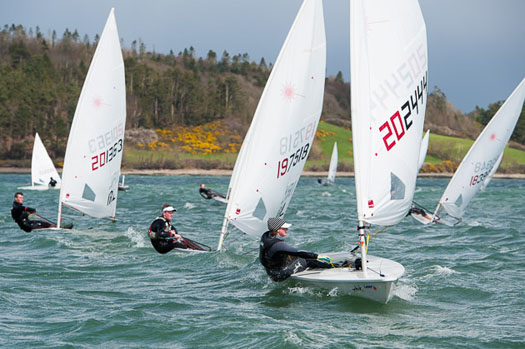

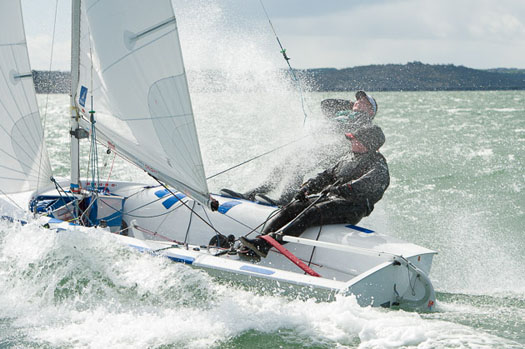

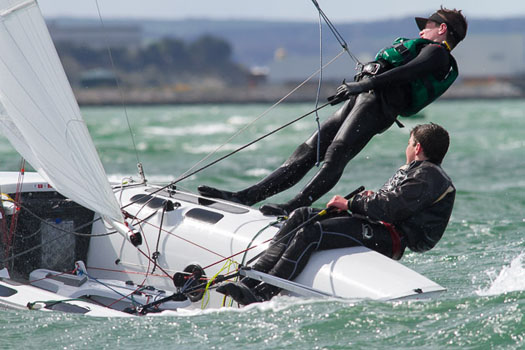
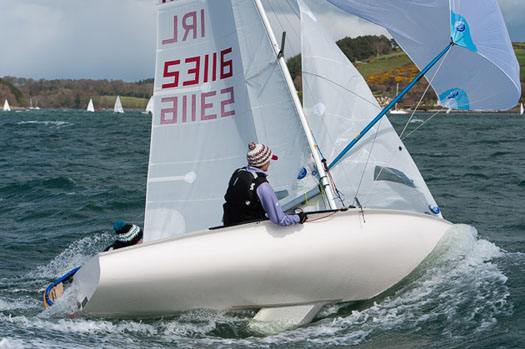
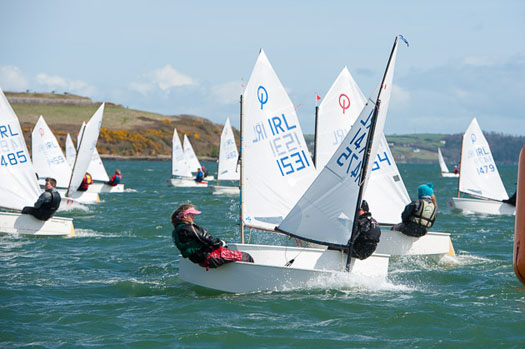
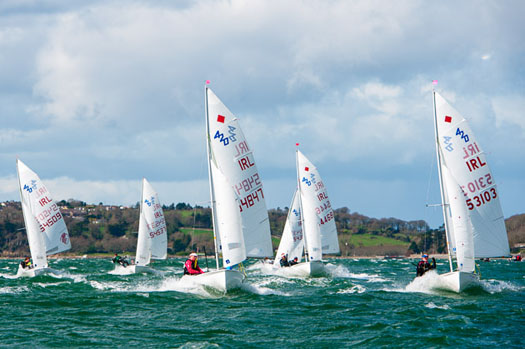

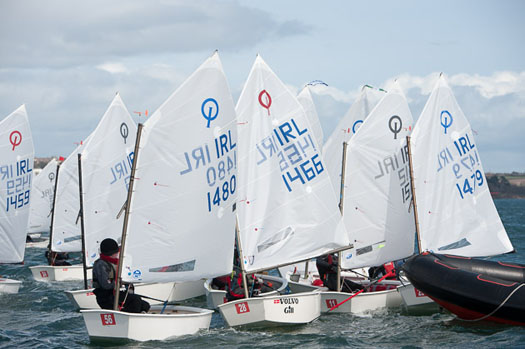





Competition Intensifies at Youth Nationals and Optimist Trials
#youthnationals – The Irish Sailing Association (ISA) Pathway Youth Nationals 2015, taking place at Royal Cork Yacht Club are in their second day of competition at Crosshaven writes Claire Bateman. Topper, 420, Laser 4.7 and Laser Radial classes are competing in selection trials for National squads and potential selection for the National Academy. The four-day event also sees the International Optimist Dinghy Association Ireland, 2015 Optimist Trials take place with over 60 entrants.
Today began as a foggy grey day with the breeze more from the south and with a fitful sun trying to break through the clouds like a patchwork quilt on the water later in the day. The wind also increased at this stage going to 16 to 18 knots with a slight hint of west in it. A third Race Committee was called to action under the highly experienced Race Officer David O'Brien of Royal Cork for the 4.7s and the Toppers who were commencing racing today. To a person doing a tour of the three race areas, looking at racing with inner loops and outer loops, separate finish boats, on the water Juries blowing whistles signaling to the unwary, or possibly not unwary, that they had infringed the rules, it all appeared a very competent and slick operation timed to the last. The race team for the 420 and Radials moved further east on the Eastern Bank opposite the Aghada Sailing and Tennis Club where they had to wait a little bit longer for the wind to reach them. When it did it was great to see these fleets surfing on the waves.
In the 420 Class Peter McCann and crew Harry Whitaker from RCYC are the current leaders, followed by Douglas Elmes and Colin O'Sullivan, RCYC/ HYC, while the younger McCann brother James and crew Bill Staunton, RCYC, are in fourth place with Lizziy McDowell and Anna O'Regan from MYC taking the third spot..
In the Laser Radial fleet after six races and one discard Conor Beirne RStYG leads Erica Ruigrok from Rush SC in second followed by Cian Byrne from the host Club in third place.
Meanwhile the 29 boat Topper fleet, having sailed three races, are now led by Geoff Power WHSC, followed by Luke McElwaine from Carlingford Lough, tied on points but with count back putting McElwaine in second place and Caoimhe Foster RCYC taking the third spot.
In the 30 boat Laser Radial Fleet Richard McGinley of the Host Club leads from Ross Morgan SSC, second followed by Rebecca O'Shaughnessy, RCYC 3rd.
In the Optimist 60 boat fleet with Ireland's top sailor Anthony O'Leary as Race Officer the fleet sailed on a traditional Optimist course and had a long day sailing four races bringing their total to seven to date on this weekend which is an Optimist Trials Event confined to sailors who qualified at regional events and the Nationals in 2014. Current leader is Tom Higgins, RStGYC, followed by Gemma McDowell, MYC and Harry Bell, HYC third.
Racing continues tomorrow (Saturday) and tensions are now mounting at this stage of the weekend. Forecast is for fresher conditions and some exciting sailing should be seen throughout the fleets.
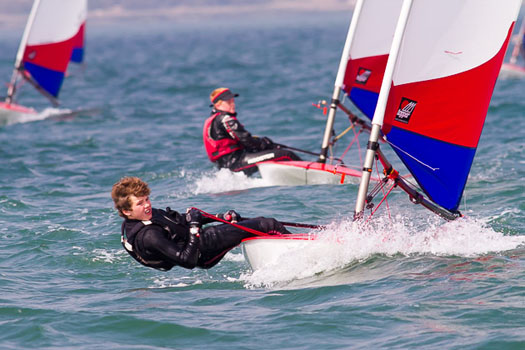
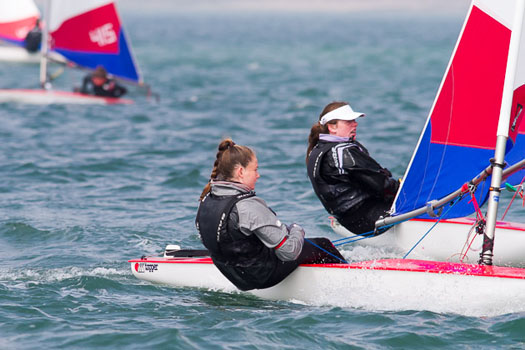
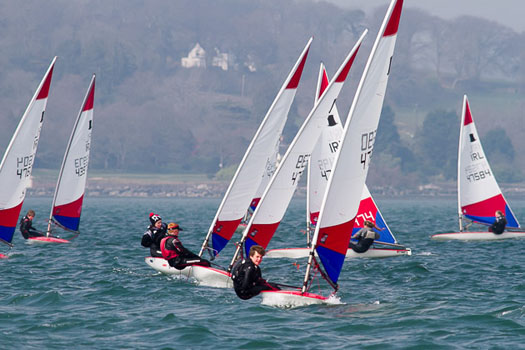
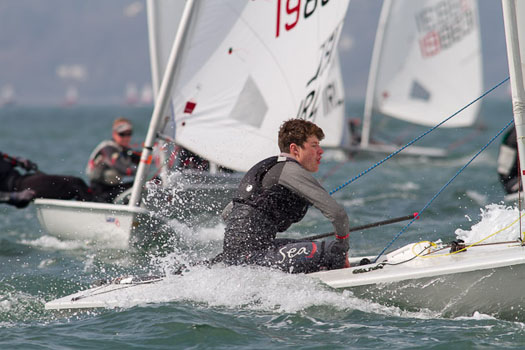
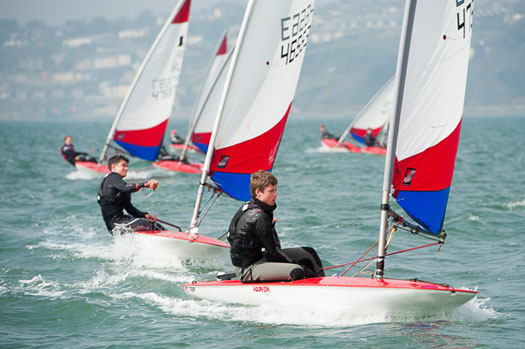
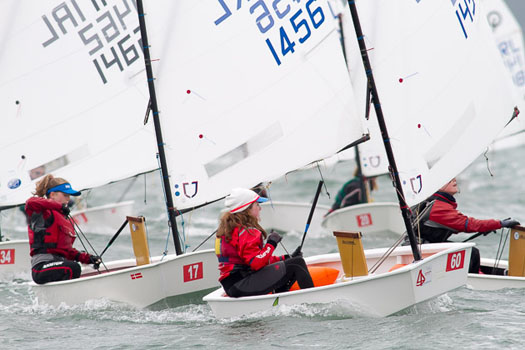
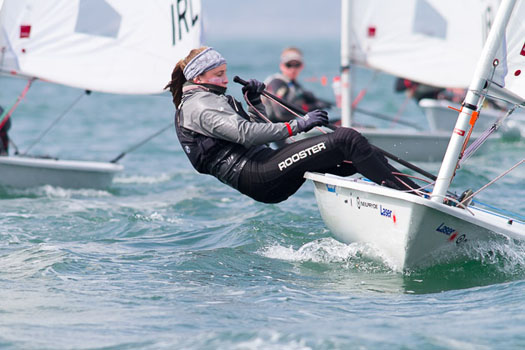
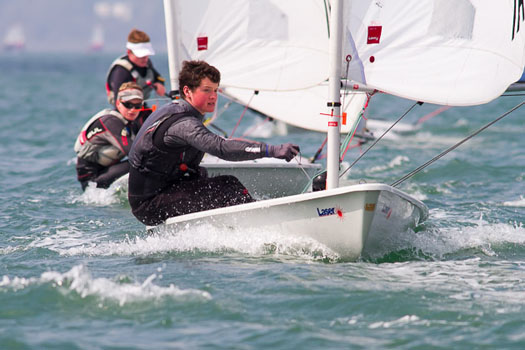
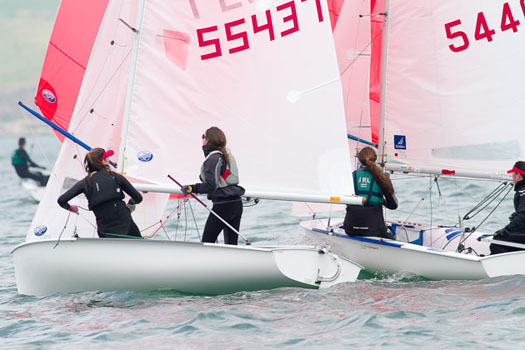
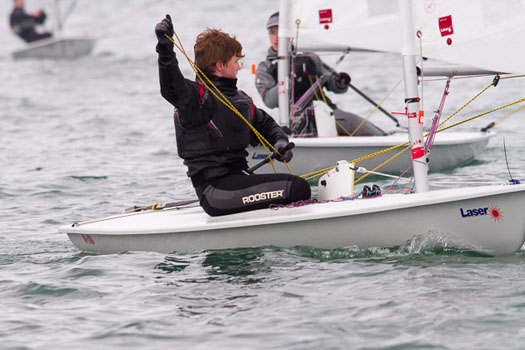
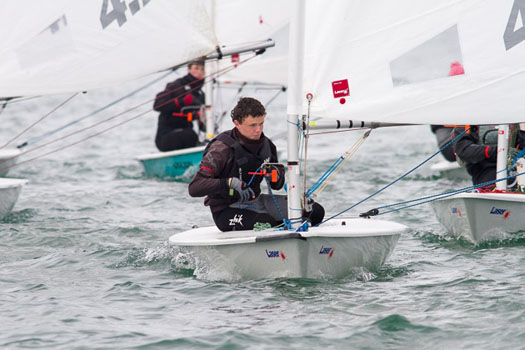
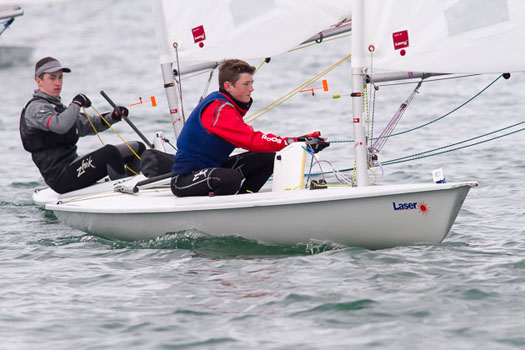



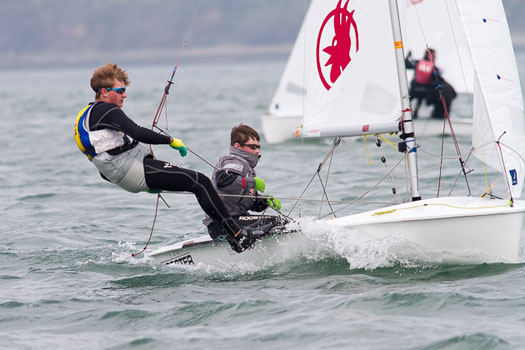
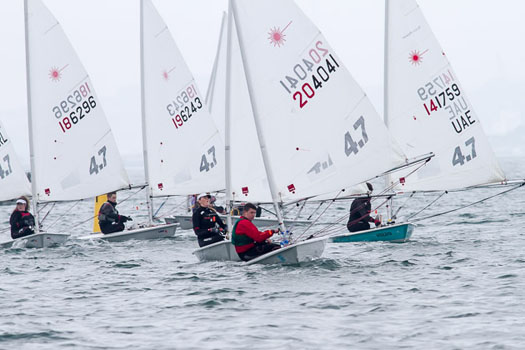

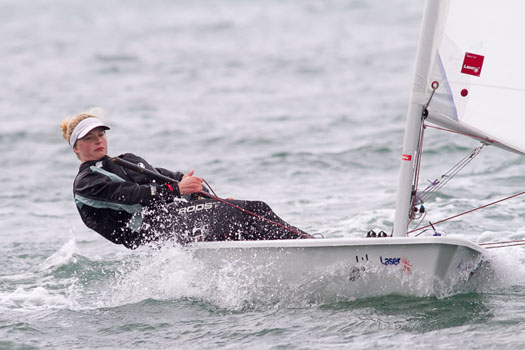
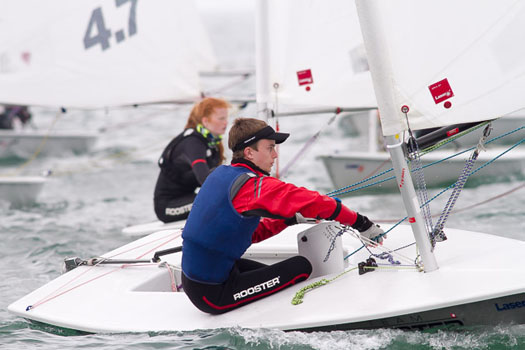
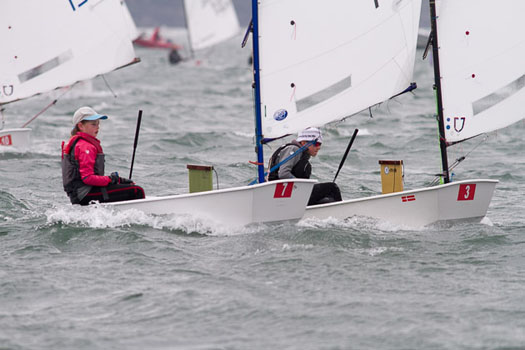
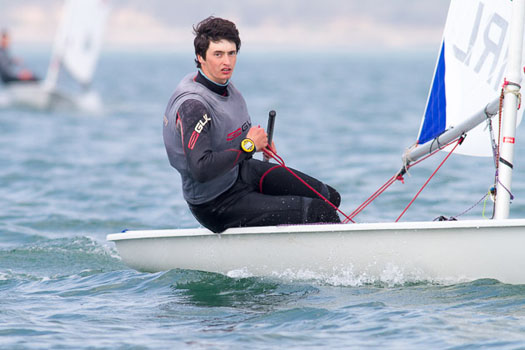
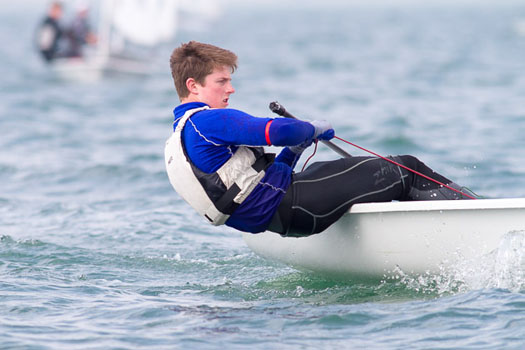


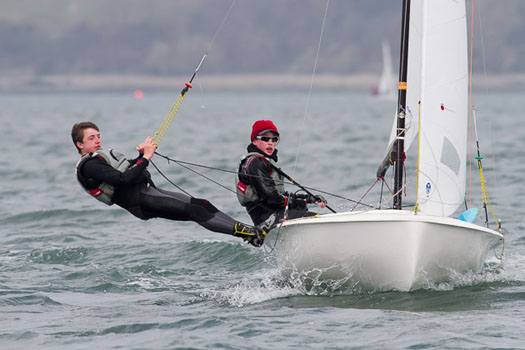
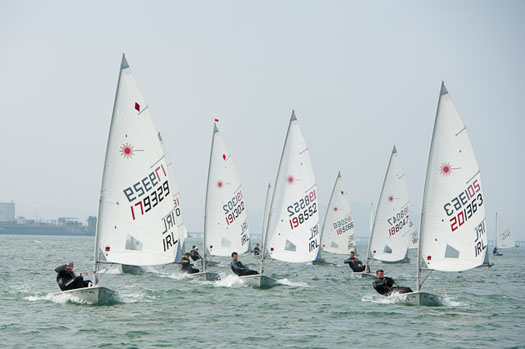

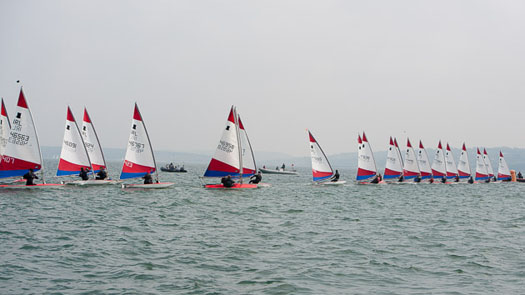
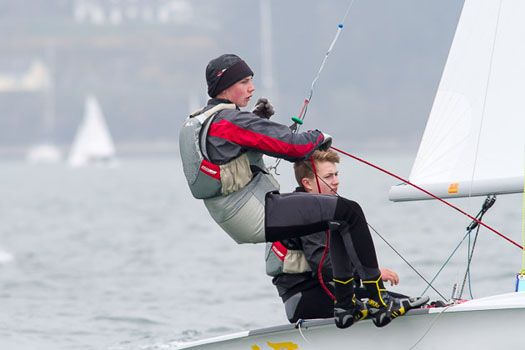

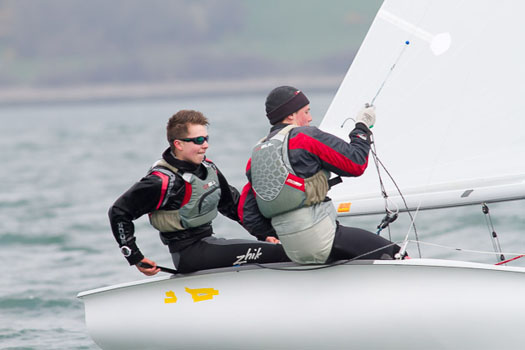
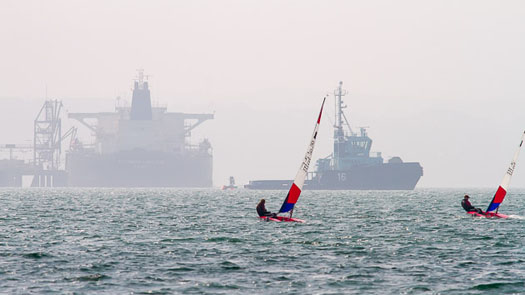
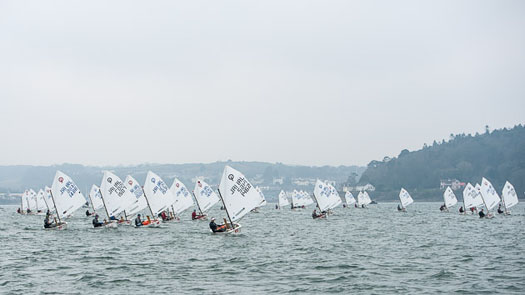
Annalise Goes Swimming, Lying Third In Palma
#trofeosofia – Annalise Murphy of the National Yacht Club in Dun Laoghaire enters the final day of racing this morning before Saturday's medal races in third place overall at the Trofeo Sofia in Palma. Breeze lovers in all classes made the most of the conditions with some perfect scores and are closing the gap on some of the regatta leaders. Today will see the last day of finals and the last chance to break into the top ten for medal race participation.
One of Annalise's arch rivals, Evi Van Acker (BEL) is continuing undefeated in the Laser Radial finals with two more bullets added to her perfect score. It has been a formidable performance eclipsing Annalise's own heavy weather speed edge. The 2014 SWC Champion is obviously enjoying the breezy conditions and is closing the gap on Alison Young (GBR) who is conserving a one point lead going into the last day of finals. "There is a very strong competition in this regatta. It has been good racing and I have been consistent in all conditions. We will see what the rest brings in." Van Acker said.
Annalise's capsize dropped her out of the top ten for the first time in the competition, scoring an 11th, her discard, in race seven. The main hope for an Irish sailing medal in Rio tweeted last night: 'A hard day for me today including a unintentional swim in the second race. In 3rd overall now'.
After scoring some big points in the first day of finals, the Spanish FX team of Tamara Echegoyen and Berta Betanzos are back in contention with a win and top five results. They are placing second overall, just four points behind Danish sisters Maiken and Anne-Julie Foght-Schutt. The Royal Irish Yacht Club's Glamrockers Andrea Brewster and Saskia Tidey are in the top half of the skiff fleet, 21st from 47.
Despite a penalty collected for starting too early, Peter Burling and Blair Tuke (NZL) are conserving a healthy 21 points lead over Erik Heil and Thomas Ploessel (GER), but can't make any more mistake. The German have also increased their lead to 22–points over Brazilian team of Bianchi and Lowbeer. Another two top ten places (7,8) scored by the Belfast Lough 49er pair Ryan Seaton and Matt McGovern keep them eighth overall and in medal race contention barring slip–ups today.
Overall Class leaders going into Friday's racing are:
470 Men: Luke Patience / Elliot Willis, GBR
470 Women: Jo Aleh / Polly Powrie, NZL
49er: Peter Burling / Blair Tuke, NZL
49er FX: Maiken Foght Schutt / Anne-Julie Foght Schutt, DEN
Finn: Giles Scott, GBR
Laser: Philipp Buhl, GER
Laser Radial: Alison Young, GBR
NACRA 17: Billy Besson / Marie Riou, FRA
RS:X Men: Julien Bontemps, FRA
RS: X Women: Charline Picon, FRA
2.4 Metre: Megan Pascoe, GBR
Dragon: Patrick Monteiro De Barros / Pedro Manuel, POR
Class winners:
Kiteboard Men: Florian Trittel, ESP
Kiteboard Women: Elena Kalinina, RUS
#rio – After an early lead this week Annalise Murphy dropped to eighth on Tuesday but this morning is back up to second overall as Spain's Trofeo Sofia regatta in Palma moves into its final stages. The Radial fleet has been full of surprises with change of leadership and some unexpected outcomes all week. Regatta favourite Marit Bouwmeester of Holland retired from the competition on the second day with a shoulder injury. Despite the absence of the world #1, the Gold fleet shows no shortage of talents. After a productive "off season" in Australia and two victories at Sail Sydney and the Melbourne SWC, Alison Young (GBR) has returned to take the lead of the Gold fleet in front of Annalise Murphy and Anne Marie Rindom (DEN). World #2 Evi van Acker (BEL) took the bullets today to climb into fourth position.
The Trofeo Sofia title will be hard fought today and tomorrow with medal races scheduled for Saturday morning.
Annalise Murphy on Form in Gusty Bay of Palma
#annalisemurphy – The National Yacht Club's Annalise Murphy dealt well with the demanding conditions in the Bay of Palma yesterday in the opening rounds of the Trofeo S.A.R. Princesa Sofia in Mallorca. In the Radial, experienced sailors Tatiana Drozdovskaya (BLR), Alison Young (GBR) and Annalise are top three after two races in gusty winds. Annalise lived up to her Irish Sports Council star billing as a 'podium athlete' and leads Irish squad fortunes so far in Spain with Irish Olympic class sailors also competing in the 49er, 49erFX and the Laser dinghy classes.
The wind played dirty tricks all day in Palma on sailors and race committees who had to juggle with big shifts and different pressure. From 4 to 20 knots, and reaching 40 in some gusts, the wind turned around the bay playing with everybody's nerves! However, the show was on with the bay covered with white caps and the 800 boats that raced their first day in the event.
The Finns were the first fleet to return ashore with two races completed. World champion Giles Scott (GBR) took the first race, managing the shifts to his advantage.
The wind played havoc in the first women 470 race with two third of the fleet in the blue group failing to finish within the time limit.
Sailing the Nacra today proved to be quite an athletic performance with gusts reaching over 30 knots. Only ten boats managed to finish the first race in both groups where capsizes and broken equipment was a common sight
Olympic medalists and World champions Peter Burling and Blair Tuke (NZL) are taking a perfect start in the 49er event with two victories. Northern Ireland skiff pair Ryan Seaton and Matt McGovern are 14th from 71.
Tamara Echegoyen and Berta Betanzos (ESP) proved just as good with a clean score in the FX. Dun Laoghaire's Andrea Brewster and Saskia Tidey are 29th from 40.
Jesper Stalheim (SWE), Tom Burton (AUS) and Lorenzo Chiavarini (GBR) have claimed the only race sailed in the three laser groups. Belfast lough's James Espey lies 64th from 150.
Only eight out of 45 windsurfers crossed the finish line in the Men RS:X yellow group. Today windy race was won by World champion Julien Bontemps (FRA) and Samuel Sills (GBR) in the Men and by Maayan DAVIDOVICH (ISR) and Sofia Keplacka (POL) in the women.
For the second day in a row, the kites didn't race. The wind was either too strong or too gusty to allow for proper racing.
Racing continues today for all classes.
Olympic Sailors Lead the Laser Fleets At Ballyholme After Day Two
#lasersailing – After Friday's blowout in the Zhik Irish Laser National Championships, it was great to see the forecast hold true on Belfast Lough yesterday with a sunny start to the morning and 12-15 knots with a few gusts and lulls along the way writes Mark Mackey. The wind stayed fairly true in direction all day with just the odd hole or squall to cope with.
Although only 2 races have been completed so far, the Laser organisation opted to stick to 3 one hour races rather than try to catch up on the schedule. James Espey in the Laser Standard again rose to the fore winning all three races and apart from the first race when Darragh O'Sullivan held him off till the first downwind, led the rest of the fleet around all the marks. Behind James, there has been great competition. Fionn "Stallion" Lyden has shown great speed downwind (or faster than Colin Leonard who came 4th in Race 1). Finn Lynch dropped out of the first group on Race 1 but cam back to score 3 and 2 on the next races and liers equal with Fionn going into the final day.
In the Radial fleet, Annalise Murphy lies first with only 5 nett point sbut had a more mixed day with some of the future young stars mixing it up. Last year's Topper World Champion and in his first year in Radials - Liam Glynn had a good day with 5,3,2 and lies in scond place overall from Cian Byrne. ISAF Youth Worlds silver medallist Seafra Guilfoyle had a worse day even with a bullet in the final race, scoring a DNF and BFD in Race 1 and 2 and drops down to 13th. Cian Byrne was the other beneficiary and moves up to 3rd overall with a win in Race 2 today.
Ballyholme's Sorcha Donnelly (who sails from Skerries but has always competed from BYC) led Race 2 but misread the earlier staring flags - one of the Irish Radial nuances is that they drop the "sausage" if there is a general recall. Race Officer Robin Gray, getting used to the tricks of some forcing general recalls so that they have shorter races, started using AP's instead 5 seconds before the start meaning they should have sailed the longer course. Sorcha led at the first mark and took a group of her fellow radials with her around the wrong course scoring RET in the end.
In the 4.7 fleet young Royal Cork's Johnny Durcan continues to set the bar with a 1 and 2, leading from Ballyholme's Rory Fekkes who won Race 2 today. Ronan Walsh, another Cork youngster, won the final race of the day
Overall:
Standards
1 James Espey 1,1,1,1,1,
2 Finn Lynch (Youth) 3,2,6,3,2
3 Fionn Lyden 2,6,3,2,3
4 Darragh O'Sullivan 7,5,2,4,4
5 Colin Leonard 4,3,4,6,8
9 Nick Walsh (Master) 14,4,11,16,12
Radials:
1 Annalise Murphy 1,1,1,2,3
2 Liam Glynn 6,4,5,3,2
3 Cian Byrne 2,6,6,1,7
4 Ross O'Sullivam 16,5,3,4,4
5 Conor O'Beirne 11,7,2,7,5
4.7
1. Johnny Durcan 2,1,1,13,2
2. Rory Fekkes 8,2,4,1,4
3. Rory Caslin 9,4,2,4,8
4. Conor Sheriff 5,8,3,15,6
5. Ronan Walsh 18,16,7,2,1
































































